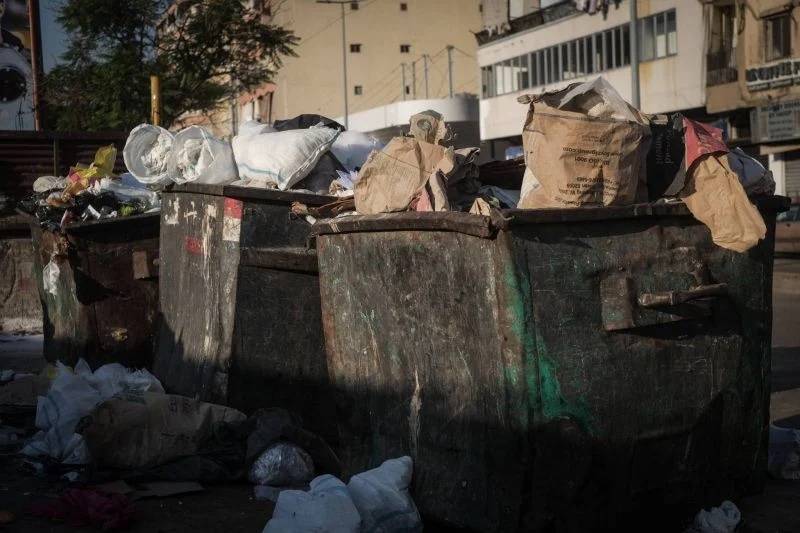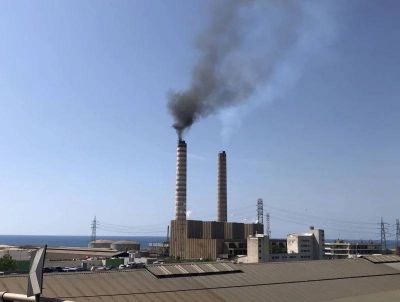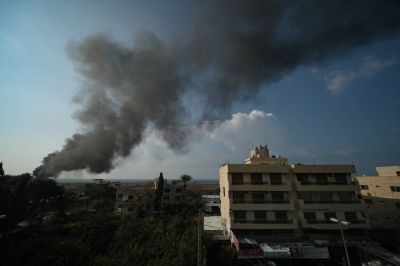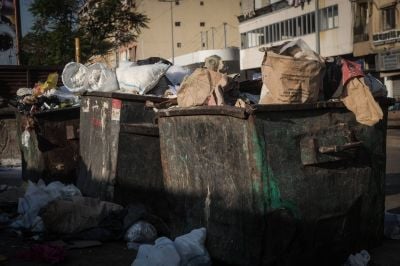
Waste in Lebanon sometimes goes uncollected for days. (Credit: João Sousa/L'Orient Today)
Two images effectively encapsulate the debacle that represents Lebanon’s household waste management over the past three decades. The first is a towering heap of garbage in Saida, South Lebanon, which has supplanted a previously treated but now neglected landfill. The second mirrors this dire situation in Jdeideh, Metn, where, despite the disappearance of the infamous “Burj Hammoud mountain”— one of the country’s primary landfill sites — a new landfill located just a kilometer away is rapidly expanding due to space constraints.
These emerging trash mountains, replacing their predecessors, epitomize the shortcomings of an overly centralized waste management system characterized by murky financing, as noted by caretaker Environment Minister Nasser Yassin in a recent address. The entire system, along with other public services in the country, teeters on the edge of collapse amid the ongoing crisis.
What factors are keeping the system afloat? How long can we stave off a major waste crisis?
Waste decreased by one-third
Since the 1990s, Lebanon’s national waste management system has remained largely stagnant, even in the aftermath of the 2015-16 garbage crisis triggered by the abrupt closure of the Naameh landfill in the Chouf area, which served as the country’s primary disposal site.
Successive waste management plans for Beirut and Mount Lebanon, the country’s most densely populated areas, hinge on contracts with a limited number of companies responsible for trash collection, street cleaning, waste treatment (often unsound) and landfill burial.
In contrast, for the rest of Lebanon, waste management solutions are sorely lacking, with only a handful of regulated landfill sites and an abundance of illegal dumpsites.
The management plan implemented in 2016 for the capital and its surrounding areas, which revolved around establishing two large coastal landfill sites (Costa Brava to the south of Beirut and Burj Hammoud/Jdeideh to the north), is now facing significant challenges due to the country’s ongoing financial crisis.
One critical aspect that is particularly affected is waste collection, primarily due to the state’s delayed payments to the two contracted companies, Ramco (responsible for serving Beirut since 2016, as well as Mount Lebanon North) and City-Blu (serving Mount Lebanon South and the southern suburbs).
“The sporadic accumulation of garbage we witness on the streets is a direct consequence of the collection slowdown, which is attributed to the fact that the companies are receiving less than 20 percent of their pre-crisis fees,” Yassin told L’Orient-Le Jour.
Paradoxically, the crisis has inadvertently mitigated the extent of damage caused by the waste management challenges by inducing changes in consumption patterns, leading to a reduction in waste volume and alteration in its composition.
Official sources indicate that waste volume has decreased by approximately one-third, dropping from an average of 3,000 tons for Beirut and Mount Lebanon to around 2,000 tons presently per day. Organic matter, which made up 50-55 percent of waste before the crisis, now accounts for 69-72 percent, according to an Environment Ministry roadmap for waste management, with the impoverishment of the population resulting in a refocusing of consumption on food products.
This shift can be attributed to the population’s financial constraints, which have compelled a shift in consumption toward essential food products, thus reducing the overall waste generated.
Minimal operations
However, the issues plaguing the waste management system extend far beyond the mere slowdown in street refuse collection. The fundamental concern lies in the treatment centers and landfill sites, which are vital components for the system’s functionality.
The pressing question revolves around the capacity of the coastal landfill sites in Costa Brava and Burj Hammoud/Jdeideh. Although the management contracts for these sites have not yet expired, fears that they are already overcapacity have become a critical concern, according to an informed source [within the environment ministry] who spoke to L’Orient-Le Jour on condition of anonymity.
The saturation of these sites, which were established in 2016, is further compounded by a significant factor: all collected waste is now directly deposited into the landfill sites without undergoing any sorting or treatment in dedicated centers. The absence of this crucial “filtering” process in the centers results in approximately 20 percent more waste ending up in the landfill sites.
In the case of the Amroussiyeh waste treatment center at Costa Brava, the contract with the operator, Jihad al-Arab, which is distinct from the landfill management contract, was not renewed upon its expiration in 2022. As for the Burj Hammoud/Jdeideh waste treatment center, it was devastated by the explosion at the Beirut port in August 2020 and has not undergone any rehabilitation works to date.
According to the [ministerial] source, Costa Brava has indeed been expanded in the past, and it is believed that it could potentially continue operations for an additional two years.
In the case of Burj Hammoud/Jdeideh site, which had long been overwhelmed, the state acquired a 120,000-square-meter plot of land adjacent to the primary landfill site in 2020. To date, only around one-third of this additional land has been utilized, and the rehabilitation and utilization of an additional 40,000 square meters has already commenced.
“We have taken measures to ensure that the system can continue functioning at a minimal level to prevent another waste crisis,” said Yassin.
He explained that in order to extend the lifespan of the main landfill sites without physically expanding them, “we will allocate $10 million dollars in Special Drawing Rights (SDRs) (note: in September 2021, Lebanon received a $1.1 billion SDR allocation from the IMF).”
According to Yassin, this funding will be used to rehabilitate currently unoccupied land, providing an additional one to one-and-a-half years of capacity, roughly until the end of 2024 or the summer of 2025.
Additionally, Yassin said, measures will be implemented to enhance waste management in Tripoli, expand the Jbeil landfill (which will also receive waste from Kesrouan) and identify a suitable site for waste management in Saida.
Derisory taxation
While Lebanon has often relied on temporary fixes to address the issue of household waste management, Yassin is now emphasizing the importance of implementing his ministry’s roadmap. The aim is to establish a more sustainable waste management system in the country.
The roadmap proposes a focus on maximizing separation of waste at source and adopting principles of the circular economy. This would entail reintegrating raw materials back into the economic cycle through various means.
Considering that the estimated daily waste production in Lebanon was 5,600 tons in 2022 (compared to 7,300 tons before the crisis), the roadmap outlines plans to modernize infrastructure and decentralize waste management by creating 15 controlled landfill sites across different areas.
The estimated budget for implementing the roadmap ranges from $88 to $113 million, including a budget of $42 to $58 million for priority measures.
According to Yassin, “this roadmap is already being partially implemented,” particularly in areas outside Beirut and Mount Lebanon.
The creation of 15 landfill sites in different areas could prove a significant challenge for those implementing the new waste management plan, considering the reluctance of the population to host such sites in their areas due to negative experiences in the past, including issues such as continuous expansion, poor management and pollution.
While acknowledging the concerns faced by the Lebanese, Yassin emphasized that comprehensive waste management requires not just landfills but also accompanying facilities, such as treatment, sorting and composting plants. He asserted that to resolve this problem, dialogue is necessary to address the obstacles and concerns raised by the public.
“For this reason, we need this year and a half or these two years of respite to put this plan in place,” he said.
Civil society activists, on the other hand, do not agree that this is a complete solution to landfills.. Ziad Abichaker, CEO of Cedar Environmental and an active participant in discussions surrounding the roadmap, highlighted that while the roadmap includes essential reforms, any efforts to convey the idea that effective waste management based on sorting and treatment could potentially obviate the need for constructing controversial landfill sites are misleading.
One significant proposed reform in the plan is the introduction of a bill that would authorize municipalities to implement a special tax for waste management.
Yassin believes that although concerns exist about people’s willingness to pay such a tax, it should be noted that this tax would be relatively light compared to others. The estimated amount per household is around $2-$3 per month.
MP Ghayath Yazbeck, chairman of Parliament’s environment committee, said that he submitted a similar bill in January. However, he remains skeptical about finding a swift and lasting solution to waste management in Lebanon. He emphasized the need for a strong government to enforce the decentralization of waste management, stating that confidence must be restored within society.
“Otherwise, creating landfill sites in a fragmented society would be extremely challenging,” he said.
This article was originally published in French in L'Orient-Le Jour. Translation by Sahar Ghoussoub.


